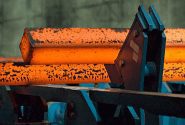Iron ore trading prices on Friday, August 20, slightly retreated from the previous day’s losses. But prices in the iron ore market are declining. However, demand from Chinese factories showed no sign of rising prices, and market participants were cautious. It seems that the cross-sectional growth of prices will not be sustainable. In the following, we will examine the factors that have caused the return of iron ore prices. Please stay with Artan Press until the end.
*** Intermittent and unstable price growth in Asian stock exchanges
While iron ore price indices in the markets are experiencing a relative increase, we are witnessing a decline in prices. However, the growth of iron ore prices was noticeable in the last days of the week. For example, 62% of the purity of Qigdao port iron ore was priced at $ 140.44 per ton. The price rose to $ 7.78 per ton. On the other hand, iron ore with low grade of 62% alumina fine from the same port was accompanied by a price increase of $ 8 per ton. Iron ore at 58 percent was $ 5.34 per tonne. Brazilian iron ore was also priced at $ 6 in the same port. This product was traded at $ 158 per ton. Australian iron ore was also traded in the cfr trading format unchanged from the previous days
*** The most important movements in the Asian iron ore trading market
Most of the January iron ore futures traded on the Dalian Commodity Exchange (DCE). Friday morning traded higher on Thursday. But the afternoon before the end of the day fluctuated by 2.0% compared to the closing price on Thursday 762.50 yuan ($ 117 per ton). Last month’s September iron ore trading deal on the Singapore Stock Exchange (SGX) also had the most trades. As of 6:42 p.m. Singapore time, it was up $ 8.45 per tonne, while Thursday’s settlement was $ 130.60 per tonne.
Price growth factors seem to be accompanied by resistance from China. A trading source in Beijing said Friday’s rise in financial markets was corrected by a sharp drop on Thursday. “Although futures markets recovered from yesterday’s big slump, the physical market is still low in liquidity as short-term positions close. Estimates show that the prices of some iron ore brands are even higher in ports,” said a Singapore-based source. China has declined slightly, but this price increase is not very much in line with them.
*** The role of reducing premiums in luck to iron ore
Sources say that in Shanxi Province, the Pilbara Blend premium continues to fall. When the Pilbara Blend premium was high, factories turned to low-grade, low-grade iron ore. Supply has already increased, but market regulation will take considerable time. Some sources predicted that iron ore prices would fluctuate next week but would decline, adding that the decline in iron ore prices was not yet complete. In Chinese ports, the Pilbara Blend Fine traded lower on Friday and did not follow the uptrend in futures trading. “Factory demand is weak, so prices are falling day by day,” said a commercial source in Shandong Province.
*** Evaluate iron ore transactions from the perspective of port inventory
A second commercial source in Shandong Province said on Friday: “Port inventory in terms of iron ore imports has increased by more than 1.6 million tons per week, reflecting the weak demand of manufacturing plants in Chinese ports. Showed a slight jump (on Friday), which was predictable, as market participants were likely to take advantage of short positions after a sharp drop in prices on Thursday. Demand in the offshore market is very weak because steel production restrictions are used in most steel mills.
این مطلب بدون برچسب می باشد.












ثبت دیدگاه